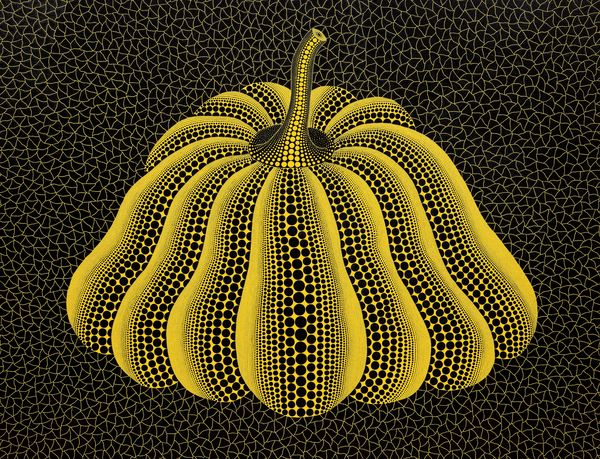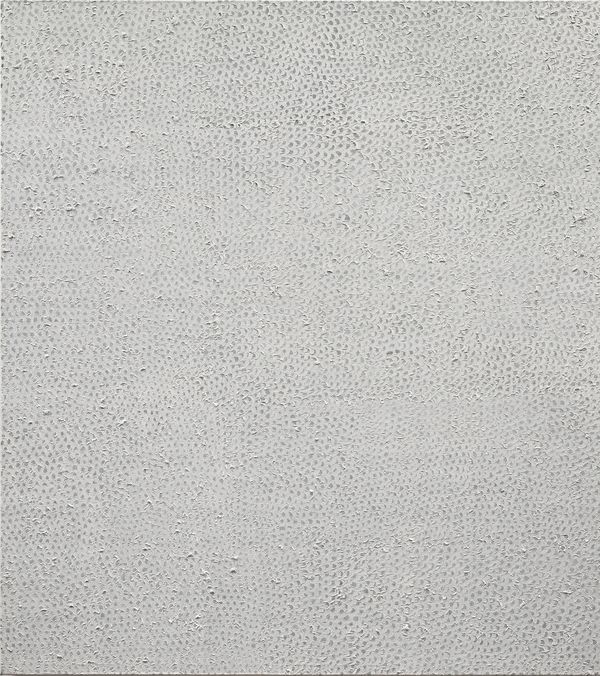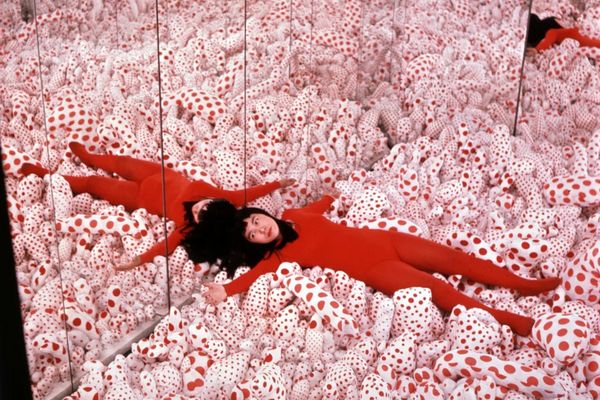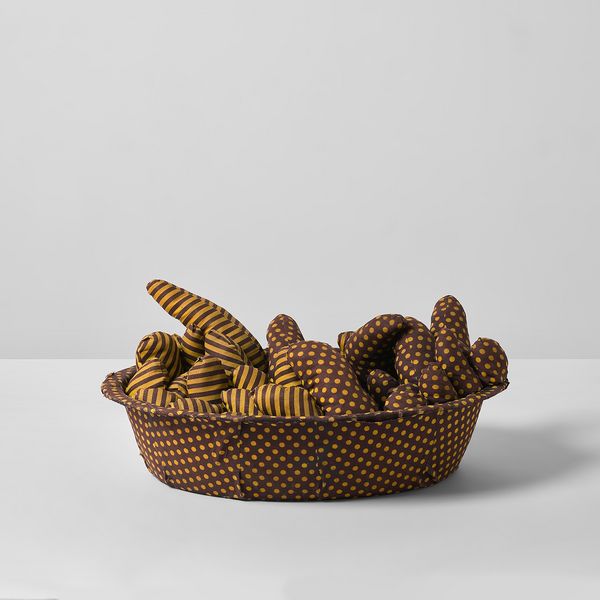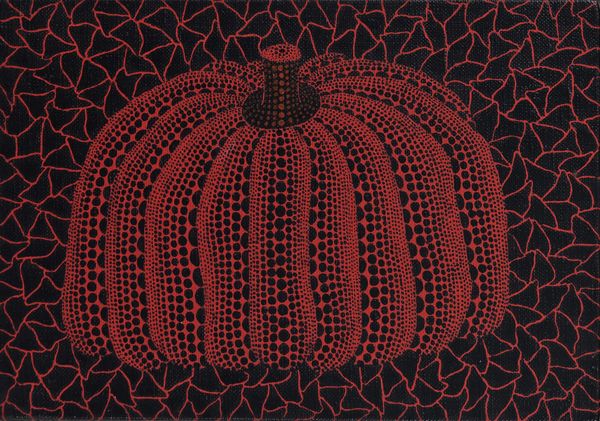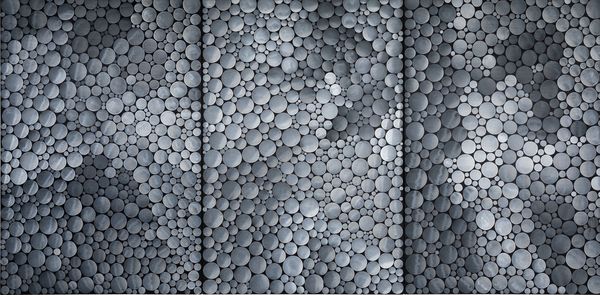Yayoi Kusama, Pumpkin, 1995
Estimate HK$ 40,000,000 - 50,000,000
20th Century & Contemporary Art Evening Sale, 30 March
Born in 1929, Kusama dreamed of being an artist from childhood, making drawings of pumpkins inspired by the ones being sold at her family plant nursery and seed farm from age 10. After successfully exhibiting in her homeland in the 1950s, she fled Japan’s wartime patriarchy for new opportunities in the United States. Living and showing work in Seattle, she corresponded with Georgia O’Keeffe, who encouraged Kusama to move to New York in 1958, during the height of the Abstract Expressionist art movement and on the cusp of its emerging Pop art scene. After seven decades of honing her own brand of counterculture, feminism, and visionary art, Kusama is considered the most successful living female artist in the world.
In anticipation of Phillips Hong Kong’s upcoming 20th Century & Contemporary Art sales, and with the increasing critical acclaim for her M+ retrospective, which many foreign visitors are seeing for the first time, we dive into seven things for seven decades. This is everything you need to know about the living legend Yayoi Kusama.
Yayoi Kusama is the most expensive living female artist
At 94, Kusama is considered one of the most successful living female artists of all time. Her work at auction reflects it, often selling for above pre-sale estimates.
In May of 2022, Phillips New York hosted their most successful auction in company history, with a new world auction record set for Kusama’s 1959 painting Untitled (Nets). Part of the artist’s coveted early series of white Infinity Net canvases, Untitled (Nets) hammered down for US$10,496,000 against estimates of US$5 - 7 million.
Yayoi Kusama, Untitled (Nets), 1959
sold for US$10,496,000 at Phillips’ 20th Century & Contemporary Art Evening Sale
May 2022, New York
Internationally known for her extraordinary and otherworldly sculptures and installations, Kusama is also well-respected and widely collected as a painter. Anticipating the minimalist art movement, her white Infinity Nets reside in notable institutional collections, including the Solomon R. Guggenheim Museum, New York, Museum of Modern Art, New York, Los Angeles County Museum of Art, and Museum of Contemporary Art in Tokyo, among others.
She lives in a psychiatric facility in Tokyo, voluntarily
"I fight pain, anxiety, and fear every day, and the only method I have found that relieved my illness is to keep creating art." — Yayoi Kusama
Since early childhood, Kusama has suffered from visual and aural hallucinations, as well as obsessive neuroses, which she meets head-on in her work.
She currently lives in a psychiatric institute in Tokyo, after voluntarily checking herself into the facility in 1977. She works daily with a team of assistants at her studio, just across the street from the institute, and returns by dinner.
Inspired by her hallucinatory experiences, Kusama's Infinity Nets series is the artist's longest-running body of work (made public when she first exhibited in New York in 1959). Its rhythmic motion and sense of infiniteness, "without beginning, end, or centre", has a relationship to her works with repetitive dots, which together have become her form of art therapy.
The backgrounds of Kusama’s coveted pumpkin canvases employ the pattern of the infinity nets, as seen in her exquisite 1995 painting Pumpkin, which is among the highlights of this season's 20th Century and Contemporary Art Hong Kong Evening Sale. Depicting a vibrant yellow pumpkin with undulating black dots, the voluptuous vegetable floats on an infinite field of interconnected lines forming delicate triangles. A large-scale acrylic on canvas, it has a pre-sale estimate of HK$40 - 50 million.
She's had a lifelong aversion to sex - but represented free love
“I began making penises in order to heal my feelings of disgust towards sex. Reproducing the objects, again and again, was my way of conquering the fear. It was a kind of self-therapy, to which I gave the name ‘Psychosomatic Art’.”—Yayoi Kusama
Kusama developed an aversion to sex after her mother forced a young Kusama to spy on her father while with his lovers. She identifies as asexual, although her work often explores phallic forms and sexuality juxtaposed with elements of humour, like her soft sculptures in Phalli's Field Infinity Room.
Yayoi Kusama in her Phalli's Field infinity room in 1965.
Image: Eikoh Hosoe/Courtesy of Ota Fine Arts, Tokyo/Singapore; Victoria Miro, London; David Zwirner, New York
Yayoi Kusama, Untitled, 1965
Estimate HK$ 1,600,000 - 2,600,000
20th Century & Contemporary Art Day Sale, 31 March
When it comes to Kusama's own relationships, the artist describes her relationship with the American visual artist Joseph Cornell as romantic yet platonic. The pair remained close until his death in 1972, which affected Kusama deeply.
Kusama's pumpkins give Warhol's soup cans a run for their money
“The first time I ever saw a pumpkin was when I was in elementary school and went with my grandfather to visit a big seed-harvesting ground…and there it was: a pumpkin the size of a man’s head… It immediately began speaking to me in a most animated manner” —Yayoi Kusama
Kusama and Andy Warhol were not only peers in New York's thriving pop art scene, her repeated motifs reportedly inspired some of his famous works. Other New York artists also took note of her innovative works, as she made her first Infinity Mirror Room before Lucas Samaras conceived his room with wall-to-wall mirrors and created soft fabric sculptures in advance of Claes Oldenburg.
A flower field in the seed nursery owned by Yayoi Kusama’s family in Matsumoto, Japan.
Image: © YAYOI KUSAMA
Kusama's diet of pumpkins during World War II, however, may partly explain her attachment to the colourful gourd, but the artist's pumpkin motif truly came to harvest through vivid hallucinations in her youth. The artist remembers accompanying her grandfather to a nursery, where she saw a pumpkin the size of a man’s head. When she reached down to pick it up, she recalls that it spoke to her. The pumpkin motif first appeared in Kusama’s travelling exhibition in Nagano and Matsumoto, Japan, 1946, when she presented Kabocha (Pumpkin).
Like the previously mentioned 1995 Pumpkin painting, her smaller but precious 1991 Pumpkin canvas captures a red, differently shaped gourd, surrounded by a linear pattern forming an infinity net. Acrylic on canvas, has a pre-sale estimate of HK$3.5 – 5.5 million.
Yayoi Kusama, Pumpkin, 1995
Estimate HK$ 40,000,000 - 50,000,000
20th Century & Contemporary Art Evening Sale, 30 March
Yayoi Kusama, Pumpkin, 1991
Estimate HK$ 3,500,000 - 5,500,000
20th Century & Contemporary Art Day Sale, 31 March
She was a fashionista well before her Louis Vuitton collaborations
"When you understand the beauty of fashion, and the beauty of small planets, you realise that fashion is a marvellous form of expression."- Yayoi Kusama
In 2012, the living legend collaborated with French fashion house Louis Vuitton and its Creative Director Marc Jacobs to reveal the Infinity Dots capsule collection. The fashion house and artist topped that collaboration earlier this year with its worldwide CREATING INFINITY: THE WORLDS OF LOUIS VUITTON AND YAYOI KUSAMA campaign, which produced a series of new creations adorned in original motifs, such as Pumpkins and Figurative Flowers, inspired by Kusama’s iconic works.
But Kusama has often shared her long-standing fondness for fashion through her art, often employing mannequins in her individual artworks and installations. Her M+ retrospective features the tableau vivant Self-Obliteration, depicting painted, polka dotted mannequins wearing wigs while posing as ladies who lunch. Likewise, in the 20th Century and Contemporary Art Hong Kong Evening Sale, Untitled (Mannequin from The Driving Image Show) presents a solo blue-painted mannequin covered in dots while wearing a wig and standing in a contrapposto pose and The Girls, an acrylic and felt pen painting of a surreal series of faces formed from flowing decorative lines. Untitled (Mannequin from The Driving Image Show) consists of a female mannequin that seems to have been caught in the act of shying away from an invisible object or subject, with the head turned to her left and the rest of the body curved to her right. The Driving Image Show was presented at Castellane Gallery in New York in 1964, the fact that some of the sculptures which were exhibited at the exhibition are now lost makes this 174 cm tall Untitled an incredibly rare, exceptional and historically relevant artwork.
Yayoi Kusama, Untitled (Mannequin from The Driving Image Show), 1966
Estimate HK$1,500,000 - 2,300,000
20th Century & Contemporary Art Evening Sale, 30 March
Yayoi Kusama, The Girls, 2004
Estimate HK$ 800,000 - 1,200,000
20th Century & Contemporary Art Day Sale, 31 March
She used polka dots to get out of her head
"Our earth is like one little polka dot, among millions of other celestial bodies." — Yayoi Kusama
Kusama's polka dots date back to hallucinatory experiences in her youth and became her signature as she navigated the New York art scene. A stark contrast to the dramatic marks popularised by abstract expressionist Jackson Pollock, Kusama's polka dots are comparatively calm, collected and offer a rhythmic optical sensation.
Her repetitive strokes also help her to eliminate the intrusive thoughts brought on by mental struggles. They are considered a means for her - and vicariously for the viewer - to "obliterate the self" and become one with the universe.
In another childhood hallucination, she recalls being in a field of flowers that all started talking to her. The heads of the flowers were like dots that went on as far as she could see. Her 2001 triptych Infinity Dots (HTI), which is one of her largest paintings to ever appear at auction, brings form to her youthful vision. Her perfectly painted dots bounce across the joined canvases like a cluster of white peonies in a shadowy, moonlit field.
Yayoi Kusama, Infinity Dots (HTI), 2001
Estimate HK$ 25,000,000 - 30,000,000
20th Century & Contemporary Art Evening Sale, 30 March
Yayoi Kusama, Pumpkin Chess Set, 2003
Estimate HK$ 2,200,000 - 3,200,000
20th Century & Contemporary Art Day Sale, 31 March
Titled 1945 to Now, the sensational M+ show allows viewers access to more than 200 works, including paintings, drawings, sculptures, installations, and archival materials that are a testament to Kusama's long and storied career. And if you cannot see the blockbuster show in Hong Kong, officials at M+ recently announced that the retrospective will travel to the Guggenheim Museum in Bilbao, where it will open on 27 June and run through 8 October, 2023.

Yayoi Kusama, Daytime, 1983
Estimate HK$500,000 - 700,000
20th Century & Contemporary Art Day Sale, 31 March
For more details, click here:
https://www.mplus.org.hk/en/exhibitions/yayoi-kusama-1945-to-now/
